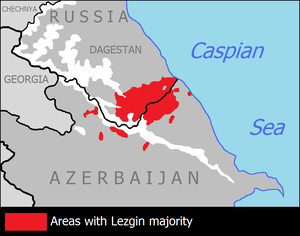لزگ (شعب)
 | |
| المناطق ذات التجمعات المعتبرة | |
|---|---|
| 473,722 385,240[1] | |
| 180,300 to 364 000[2][3] | |
| 16,000 | |
| 4,349 | |
| 4,300 | |
| 3,481 | |
| 2,603 | |
| 2,000–10,000 | |
| 404 | |
| 280 | |
| 121 | |
| 82 | |
| 74 | |
| 44–2,900 | |
| اللغات | |
| اللزگية | |
| الدين | |
| أقلية سنية، وشيعية[4] | |
| الجماعات العرقية ذات الصلة | |
| Tabasarans، آغول، روتول، بودوخ، Kryts، تساخور، Archi، شاهداغ، أودي، وشعوب شمال شرق القوقاز الأخرى | |
لِزگ (Lezgian: лезгияр, lezgiyar، بالروسية: лезгины، lezginy؛ إنگليزية: Lezgians، ويُدعَون أيضاً لزگين Lezgins، لزگي، لزگيّون) هم جماعة عرقية لزگية موطنها في لزگيا الواقعة في جنوب داغستان وشمال شرق أذربيجان ويتكلمون اللغة اللزگية.
اسم العرق



أصل اسم العرق لِزگ يتطلب المزيد من البحث. إلا أن معظم الباحثين يعتبرونه صرف من كلمة "لِگي" القديمة وكلمة لـَكزي في مطلع العصور الوسطى.
Modern-day Lezgins speak Northeast Caucasian languages that have been spoken in the region before the introduction of Indo-European languages. They are closely related, both culturally and linguistically, to the Aghuls of southern Dagestan and, somewhat more distantly, to the Tsakhurs, Rutuls, and Tabasarans (the northern neighbors of the Lezgins). Also related, albeit more distantly, are the numerically small Jek, Kryts, Shahdagh, Budukh, and Khinalug peoples of northern Azerbaijan. These groups, together with the Lezgins, form the Samur branch of the indigenous Lezgic peoples.
Lezgins are believed to descend partly from people who inhabited the region of southern داغستان in the Bronze Age. However, there is some DNA evidence of significant admixture during the last 4,000 years with a Central Asian population, as shown by genetic links to populations throughout Europe and Asia, with notable similarities to the Burusho of Pakistan.[7]
Prior to the Russian Revolution, the Lezgins did not have a common self-designation as an ethnic group. They referred to themselves by village, region, religion, clan, or free society. Before the revolution, the Lezgins were called "Kyurintsy", "Akhtintsy", or "Lezgintsy" by the Russians. The ethnonym "Lezgin" itself is quite problematic. Prior to the Soviet period, the term "Lezgin" was used in different contexts. At times, it referred only to the people known today as Lezgins. At others, it referred variously to all of the peoples of southern Daghestan (Lezgin, Aghul, Rutul, Tabasaran, and Tsakhur); all of the peoples of southern Daghestan and northern Azerbaijan (Kryts Jek, Khinalug, Budukh, Shahdagh); all Nakh-Daghestani peoples; or all of the indigenous Muslim peoples of the Northeast Caucasian peoples (Caucasian Avars, Dargwa, Laks, Chechens, and Ingush). In reading pre-Revolutionary works, one must be aware of these different possible meanings and the scope of the ethnonym "Lezgin".
التاريخ

انظر أيضاً
- Gotfrid Hasanov
- Nazim Huseynov
- Nader's Dagestan campaign
- Suleyman Kerimov
- Suleyman Stalsky
- Lezginka
- اللغة اللزگية
- Lezgistan
- شعوب القوقاز
- Northeast Caucasian people
الهامش
- ^ "Национальный состав населения Российской Федерации согласно переписи аселения 2010 года". gks.ru. Retrieved 2011-02-04.
- ^ http://www.ethnologue.com/language/lez
- ^ خطأ استشهاد: وسم
<ref>غير صحيح؛ لا نص تم توفيره للمراجع المسماةazeristats - ^ "The Role of Ethnic Minorities in Border Regions: Forms of their composition, problems of development and political rights". Retrieved 18 December 2014.
- ^ خطأ استشهاد: وسم
<ref>غير صحيح؛ لا نص تم توفيره للمراجع المسماةJM - ^ Ethnologue report for Lezgi
- ^ New York Times, 2014, "Genetic Mixing" (February 13; interactive). (Access: October 15 2014).
ببليوگرافيا
- Minahan, J. (2002) Encyclopaedia of stateless nations: L-R, Greenwood Publishing Group. ISBN 9780313321115.
- Yarshater, E. (1983) The Cambridge history of Iran, Volume One, Cambridge University Press: Cambridge. ISBN 0-521-20092-X.
- "Related ethnic groups" needing confirmation
- Pages using infobox ethnic group with unsupported parameters
- Articles using infobox ethnic group with image parameters
- Articles containing إنگليزية-language text
- Pages using Lang-xx templates
- Lezgian people
- شعوب القوقاز
- Indigenous peoples of Europe
- جماعات عرقية في أوروپا
- Ethnic groups in Azerbaijan
- جماعات عرقية في داغستان
- جماعات عرقية في روسيا
- Muslim communities of Russia

